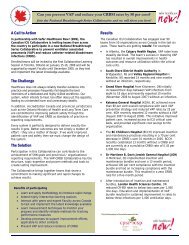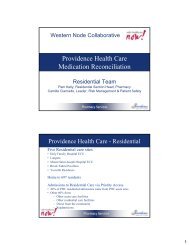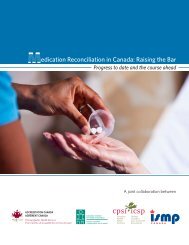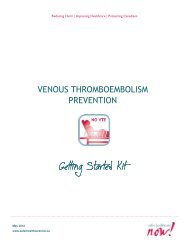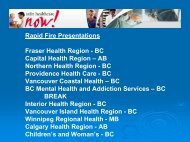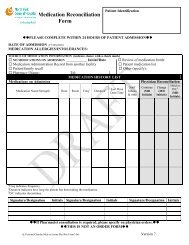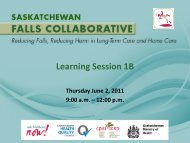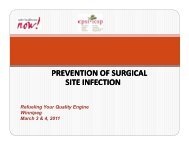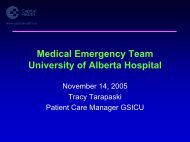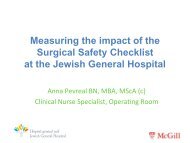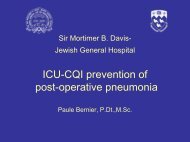VAP Getting Started Kit - Safer Healthcare Now!
VAP Getting Started Kit - Safer Healthcare Now!
VAP Getting Started Kit - Safer Healthcare Now!
You also want an ePaper? Increase the reach of your titles
YUMPU automatically turns print PDFs into web optimized ePapers that Google loves.
<strong>Safer</strong> <strong>Healthcare</strong> <strong>Now</strong>! Prevent Ventilator Associated Pneumonia <strong>Getting</strong> <strong>Started</strong> <strong>Kit</strong><br />
Additional Evidence Based Components of Care<br />
1. Hand Hygiene<br />
The required practice is to perform hand hygiene according to the four moments of hand hygiene<br />
which include before and after approaching a mechanically ventilated patient (as described in<br />
the four moments of hand at www.handhygiene.ca)<br />
The key role of healthcare workers washing their hands in the transmission of pathogens from<br />
patient to patient was demonstrated over 150 years ago by Ignaz Semmelweis. This Viennese<br />
obstetrician dramatically reduced the mortality related to puerperal fever by implementing<br />
systematic hand disinfection in chlorinated lime before examining patients. Since then, routine<br />
hand washing before and after patient contact has been espoused as the most important<br />
infection control measure in hospitals. The endemic transmission of exogenous staphylococci and<br />
other potential pathogens by the hands of healthcare workers has been well-documented. 135<br />
This phenomenon is of particular concern in the ICU where patient care necessitates frequent<br />
contact. In fact, one study has shown that on average each ICU patient experiences on average<br />
159 direct and 191 indirect contacts by healthcare workers in a 24 hour period. Much of the<br />
previous literature in this field has identified the very poor rates of hand washing by healthcare<br />
workers before and after patient contacts (21-66%). 136<br />
Hospital-wide programs to improve compliance with hand hygiene have generally shown<br />
improvement in practices over the short term but more recently they have also shown reductions<br />
in nosocomial infections. Rosenthal and colleagues found a 42 % decrease in overall nosocomial<br />
infections (47.55 to 27.93 infections per 1000 patient-days) with implementation of an<br />
education, training and performance feedback program in 2 Argentinean ICUs. This was<br />
attributed to the observed progressive increase in hand hygiene practices over 20 months,<br />
climbing from a compliance rate of 23.1% at baseline to 64.5 % at the end of the study. 137<br />
Similarly, Johnson et al implemented a multifaceted hand hygiene culture-change program in<br />
five clinical areas of a large Australian university teaching hospital that had high levels of MRSA.<br />
They found significant reductions in hospital-wide rates of total clinical MRSA isolates (40%<br />
decrease), patient episodes of MRSA bacteremia (57% reduction) and clinical isolates of ESBLproducing<br />
E. coli and Klebsiella sp. (90% reduction) over 36 months in association with a doubling<br />
in hand hygiene compliance (21 to 42%). 138<br />
Thus, attention to hand hygiene plays an important role in the prevention of nosocomial<br />
infections in the ICU and is likely to be more rewarding since the advent of alcohol-based hand<br />
rub solutions. 139<br />
There is an emerging consensus among experts that educational campaigns alone have not<br />
produced sustained improvement. 140 Rather, in order to succeed, strategies must be multimodal<br />
and include at least 5 components: staff education, monitoring of practices and performance<br />
feedback, reminders in the workplace, adoption of an institutional safety climate, and, last but<br />
not least, a system change—the preferential recourse to the use of alcohol-based hand rub as the<br />
new standard for patient care. 141 Moreover, in its testing of the WHO recommendations, Ontario<br />
June 2012 28



